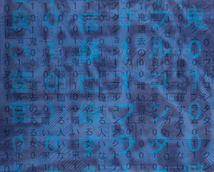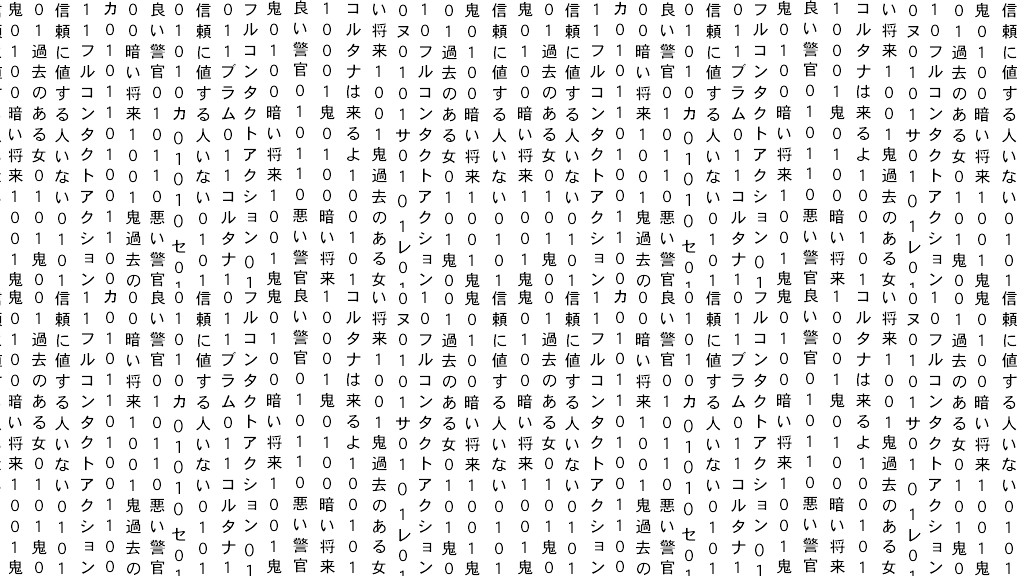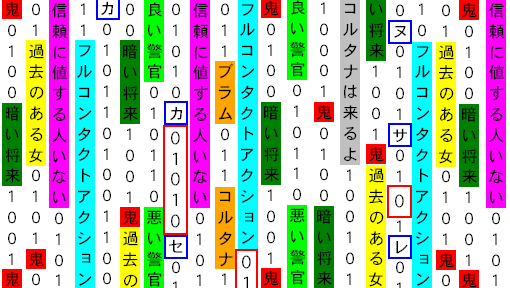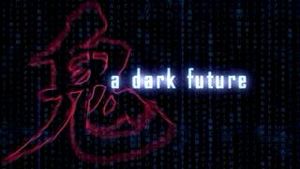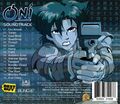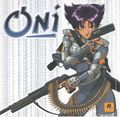Oni matrix: Difference between revisions
(let's dish this out already) |
(tried to streamline some dense prose; moved trivia to footnotes; color-coded text to match the color-coded matrix) |
||
| Line 1: | Line 1: | ||
[[Image:Oni_matrix_overlays.png|thumb|right|214x172px|What is the matrix?]] | [[Image:Oni_matrix_overlays.png|thumb|right|214x172px|<center>What is the matrix?</center>]] | ||
The '''"Oni matrix"''' is a pattern of binary digits | The '''"Oni matrix"''' is Bungie's name for a pattern of binary digits, [[wikipedia:Kana|kana]] and [[wikipedia:Kanji|kanji]] used recurrently as a background element in [[:Category:Promotional_art|promotional art]], [[:Category:Packaging_images|packaging]], [[:Category:Splashscreens|level splashscreens]], and even the [[:Image:Main_Title_Screen.png|Main Menu]]. It appears in animated form in Oni's [[Trailers|1999 trailer]]. It was likely inspired by "[[wp:The Matrix|The Matrix]]", which came out during Oni's marketing phase.<ref>"The Matrix" came out in early 1999, but the iconic [[wp:Matrix digital rain|"digital rain"]] visual was revealed somewhat earlier, in a [https://www.youtube.com/watch?v=m8e-FF8MsqU&t=2m25s late 1998 trailer].</ref> | ||
A distinctive feature of Oni's "matrix" is the non- | A distinctive feature of Oni's "matrix" is the non-random meaning of the Japanese symbols, which was deciphered by dedicated fans over the years. Digest results of that research are presented below (a detailed historical account is available [[/Translation_effort|HERE]]). | ||
==Visual appearance== | ==Visual appearance== | ||
===Bungie West's template=== | ===Bungie West's template=== | ||
The original source file for the matrix is called "japanese matrix.psd" in Bungie West's archives.<ref>Point of interest: the other background template from the archives, "circuitpatterngrayscale.psd", is in fact a derivative of "japanese matrix.psd", featuring the upper-left 29x25 cells (out of 42x28). This is likely the reason that some of the matrix shows up on the Main Menu, which uses the circuitry background as one layer among many.</ref> | |||
{|cellpadding=0 cellspacing=0 | {|cellpadding=0 cellspacing=0 | ||
|width=1034px| | |width=1034px| | ||
{{divhide| | {{divhide|japanese matrix.psd}} | ||
[[Image:Japanese matrix on white.jpg]] | [[Image:Japanese matrix on white.jpg]] | ||
{{divhide|end}} | {{divhide|end}} | ||
|} | |} | ||
There are 42 columns and 28 rows, but they're actually made up of four identical quadrants. The kana/kanji form [[seven]] unique phrases when read from top to bottom (therefore we assume the binary digits are read from top to bottom as well). There is no continuity from one column to another, so unlike traditional Japanese the columns are not to be read right-to-left. | |||
The [[Oni_(myth)|oni kanji]] ('''鬼''', red background) is the most recurrent element in the matrix, with 11 instances per quadrant. It mostly appears surrounded by binary digits, although it is also seen prefixed to '''kako no aru onna 過去のある女''' (yellow). | |||
Here is all the unique material, color-coded: | |||
[[Image:Japanese_matrix_quadrant_colored.png]] | [[Image:Japanese_matrix_quadrant_colored.png]] | ||
---- | ---- | ||
The [[seven]] unique phrases are as follows: | |||
*'''<span style="background:rgb(0,128,0); border-radius:0.33em; padding:0.25em">kurai i sho-rai</span>''' (暗い将来–): "a dark future" (the first of Oni's taglines in the [[Trailers|1999 trailer]])<ref>One instance of '''kurai i sho-rai 暗い将来''' is truncated (first kana missing); vertical wrapping puts it next to the end of '''kako no aru onna 過去のある女'''.</ref>; | |||
*'''<span style="background:rgb(255,255,0); border-radius:0.33em; padding:0.25em">ka-ko no a-ru onna</span>''' (過去のある女): literally "a certain woman of the past", likely intended to mean "the past of a certain woman" or "a woman with a past", echoing Konoko's "uncertain past" (the second tagline)<ref>One instance of '''ka-ko no a-ru onna 過去のある女''' is truncated (second half missing), another is prefixed with '''oni 鬼'''.</ref>; | |||
The [[seven]] | *'''<span style="background:rgb(255,0,255); border-radius:0.33em; padding:0.25em">shin-rai ni atai-su-ru hito i-na-i</span>''' (信頼に値する人いない): literally "[there is] no one worthy of trust", likely intended to mean "no one left to trust" (the third tagline); | ||
*'''kurai i sho-rai | *'''<span style="background:rgb(0,255,255); border-radius:0.33em; padding:0.25em">fu-ru ko-n-ta-ku-to a-ku-shi-yo-n</span>''' (ㇷルコンタクトァクシヨン): a katakana transcription of "full contact action" (one of Oni's [[Oni/Positioning|Unique Selling Points]]); | ||
*'''<span style="background:rgb(0,255,0); border-radius:0.33em; padding:0.25em">i-i kei-kan / waru-i kei-kan</span>''' (良い警官 / 悪い警官): "good cop" / "bad cop" (likely a reference to the ambiguity of the [[Oni/Early_Story|early story]])<ref>As the streamer wraps around, you actually get a contiguous 悪い警官良い警官, i.e., "bad cop good cop" instead of "good cop" / "bad cop".</ref>; | |||
*'''ka-ko no a-ru onna | *'''<span style="background:rgb(255,165,0); border-radius:0.33em; padding:0.25em">bu-ra-mu / ko-ru-ta-na</span>''' (ブラム / コルタナ): "Blam" / "Cortana" (cross-marketing for the upcoming Halo; "Blam" was the codename for Halo as well as a [[Blam|general Bungie meme]]); | ||
*'''<span style="background:rgb(192,192,192); border-radius:0.33em; padding:0.25em">ko-ru-ta-na wa kuru ru yo</span>''' (コルタナは来るよ): "Cortana is coming" (more cross-marketing)<ref>The '''ru る''' kana is superfluous here, i.e., it should be just '''wa kuru yo は来よ''', not '''wa kuru ru yo は来るよ'''.</ref>. | |||
*'''shin-rai ni atai-su-ru hito i-na-i | |||
*'''fu-ru ko-n-ta-ku-to a-ku-shi-yo-n | |||
*'''i-i kei-kan / waru-i kei-kan | |||
*'''bu-ra-mu / ko-ru-ta-na | |||
*'''ko-ru-ta-na wa kuru ru yo | |||
---- | ---- | ||
The five "lone kana" ('''ka カ''', '''se セ''', '''nu ヌ''', '''sa サ''', and '''re レ'''; blue outline) are likely filler. | The five "lone kana" ('''ka カ''', '''se セ''', '''nu ヌ''', '''sa サ''', and '''re レ'''; blue outline) are likely filler. | ||
---- | ---- | ||
The binary digits do not seem to carry any meaning | The binary digits do not seem to carry any meaning either. If "Big Endian" order is assumed for the digits, then the following numbers occur: | ||
*'''2892''' (0101101001100), '''37''' (100101), '''22''' (010110), '''17''' (10001), '''10''' (01010), | *'''2892''' (0101101001100), '''37''' (100101), '''22''' (010110), '''17''' (10001), '''10''' (01010), | ||
*'''9''' (1001), '''5''' (0101), '''4''' (0100), '''3''' (011, 11), '''2''' (10), '''1''' (01, 1), and '''0''' (00, 0). | *'''9''' (1001), '''5''' (0101), '''4''' (0100), '''3''' (011, 11), '''2''' (10), '''1''' (01, 1), and '''0''' (00, 0). | ||
If "Little Endian" is allowed, then six additional readings/interpretations emerge: | If "Little Endian" is allowed, then six additional readings/interpretations emerge: | ||
*'''3132''' (0011001011010), '''41''' (101001), '''26''' (011010), '''10''' (1010), '''2''' (0010), and '''6''' (110). | *'''3132''' (0011001011010), '''41''' (101001), '''26''' (011010), '''10''' (1010), '''2''' (0010), and '''6''' (110). | ||
Alas, none of those numbers are particularly Oni | Alas, none of those numbers are particularly relevant to Oni or Bungie. | ||
---- | ---- | ||
Last but not least: note the uneven width of the columns, the slight variations in the vertical alignment (not a perfect grid), and how the use of a larger font size for some of the binary digits (red outline) causes rather sloppy-looking truncated "1"s at the bottom of the '''ka/se''' and '''nu/sa/re''' columns. | Last but not least: note the uneven width of the columns, the slight variations in the vertical alignment (not a perfect grid), and how the use of a larger font size for some of the binary digits (red outline) causes rather sloppy-looking truncated "1"s at the bottom of the '''ka/se''' and '''nu/sa/re''' columns. | ||
Somewhat surprisingly, all the imperfections of the template are faithfully reproduced at higher resolutions. We are in fact seeing those truncated "1"s (and the truncated Japanese phrases) in every instance of the matrix (trailer, promotional art, | Somewhat surprisingly, all the imperfections of the template are faithfully reproduced at higher resolutions. We are in fact seeing those truncated "1"s (and the truncated Japanese phrases) in every instance of the matrix (trailer, promotional art, in-game splashscreens, etc.) – although some exceptions may exist. | ||
===Scrolling | |||
===Scrolling version=== | |||
[[Image:1999_trailer_opening.jpg|thumb|right|Trailer opening]] | [[Image:1999_trailer_opening.jpg|thumb|right|Trailer opening]] | ||
The 1999 trailer's screen proportions exactly match those of | The 1999 trailer's screen proportions exactly match those of "japanese matrix.psd". Also, during the titles we see exactly 28 symbols down and 42 across. Thus, although the trailer's low resolution makes it hard to tell for sure, it is safe to assume that the template was made specifically for the trailer, and that the trailer's two sheets of "matrix data" sliding up and down are simple copies of "japanese matrix.psd". The only thing that needs to be determined is the sliding speed, initial offset timing, and shape of the holes in the frontmost matrix sheet (the one that slides upwards). | ||
It takes about 5 seconds for the columns (28 symbols) to cover the height of the screen. The holes in the upwards-moving foreground columns, as well as the initial offsets of the columns at the start of each title sequence, are not documented at this point. | |||
===Static version=== | |||
===Static | Hardly an exhaustive list, this is merely meant as a representative collection of matrix sightings, more or less high-quality, for anyone curious to see how ubiquitous the matrix was. Sometimes two layers of the matrix are even present at different scales. | ||
Hardly an exhaustive list, this is merely meant as a representative collection of matrix sightings, more or less high quality, for anyone | |||
<gallery> | <gallery> | ||
File:OST_case_back.jpg | File:OST_case_back.jpg | ||
| Line 71: | Line 65: | ||
Image:Chapter_14_.MISSION_COMPLETE_(HD).jpg | Image:Chapter_14_.MISSION_COMPLETE_(HD).jpg | ||
</gallery> | </gallery> | ||
Some packaging art | |||
Some packaging art featured "binary rain" instead of a mix of binary and kana/kanji. The binary sequences have not been studied (filler, most likely). | |||
<gallery> | <gallery> | ||
File:Early_box_art.jpg | File:Early_box_art.jpg | ||
| Line 78: | Line 74: | ||
File:Windows_(DE)_jewel_case_art_-_front.jpg | File:Windows_(DE)_jewel_case_art_-_front.jpg | ||
</gallery> | </gallery> | ||
==Notable | |||
==Notable lookalikes== | |||
===The Matrix (1999)=== | ===The Matrix (1999)=== | ||
The Matrix's code used a custom typeface consisting of decimal digits, Latin capital letters and [[wp:Half-width kana|half-width kana]] - all of them mirrored horizontally. The characters do not actually slide downwards across the screen | The Matrix's code used a custom typeface consisting of decimal digits, Latin capital letters and [[wp:Half-width kana|half-width kana]] - all of them mirrored horizontally. The characters do not actually slide downwards across the screen; instead they are on a static grid which refreshes in downwards-scrolling sequences. | ||
In the Oni 1999 trailer, the columns are actually sliding up and down, rather than revealed through in-place refreshing. This is a major difference between the animated Oni matrix and Matrix code. The other differences are: | In the Oni 1999 trailer, the columns are actually sliding up and down, rather than revealed through in-place refreshing. This is a major difference between the animated Oni matrix and Matrix code. The other differences are: | ||
*the glyphs themselves (in Oni they are not mirrored, the kana are full-width, and the digits are binary rather than decimal); | *the glyphs themselves (in Oni they are not mirrored, the kana are full-width, and the digits are binary rather than decimal); | ||
*Oni's lesser randomness (a small number of actually meaningful phrases and a uniform sliding motion, as opposed to the utterly unintelligible | *Oni's lesser randomness (a small number of actually meaningful phrases and a uniform sliding motion, as opposed to the utterly unintelligible Matrix code). | ||
===Ghost in the Shell (1995)=== | ===Ghost in the Shell (1995)=== | ||
The inspiration for the "digital rain" in "The Matrix" in considered to be the opening titles of "Ghost in the Shell" (1995) ([https://www.youtube.com/watch?v=c4tj7I2-q1s&t=26s seen here]). In this case we are looking at a monochrome screen (hexagonal halftone) densely packed with lines of fixed-width characters (with slight height variations from one line to another). There are no letters or kana, and the digits are decimal rather than binary. Instead of scrolling, the digits are flickering in rapid succession, seemingly at random (patterns can be identified only by looking at snapshots). The opening titles' lines are gradually "extracted" from this rapid succession of digits, not unlike a [[wp:Split-flap_display|split flap display]]. | |||
Since Oni's 1999 trailer specifically uses the sliding matrix columns as a background for titles (with titles seemingly emerging from the flowing data), it is possible that the GITS opening had a direct influence on the trailer as well. | Since Oni's 1999 trailer specifically uses the sliding matrix columns as a background for titles (with titles seemingly emerging from the flowing data), it is possible that the GITS opening had a direct influence on the trailer as well. | ||
===Meteo (1990)=== | ===Meteo (1990)=== | ||
Meteo is an old Hungarian thriller. It is | Meteo is an old Hungarian thriller. It is far lesser-known than "The Matrix" or GitS, but it has an [https://www.youtube.com/watch?v=fpuijKR-054&t=1m50s interesting scene] with a perplexed coder staring at pages of cryptic data. Some of the code uses densely packed characters from the extended ASCII table, flickering at random, and visually similar to Matrix code. | ||
==Notes== | ==Notes== | ||
<references/> | <references/> | ||
[[Category:Oni history]] | [[Category:Oni history]] | ||
Revision as of 13:34, 25 April 2021
The "Oni matrix" is Bungie's name for a pattern of binary digits, kana and kanji used recurrently as a background element in promotional art, packaging, level splashscreens, and even the Main Menu. It appears in animated form in Oni's 1999 trailer. It was likely inspired by "The Matrix", which came out during Oni's marketing phase.[1]
A distinctive feature of Oni's "matrix" is the non-random meaning of the Japanese symbols, which was deciphered by dedicated fans over the years. Digest results of that research are presented below (a detailed historical account is available HERE).
Visual appearance
Bungie West's template
The original source file for the matrix is called "japanese matrix.psd" in Bungie West's archives.[2]
There are 42 columns and 28 rows, but they're actually made up of four identical quadrants. The kana/kanji form seven unique phrases when read from top to bottom (therefore we assume the binary digits are read from top to bottom as well). There is no continuity from one column to another, so unlike traditional Japanese the columns are not to be read right-to-left.
The oni kanji (鬼, red background) is the most recurrent element in the matrix, with 11 instances per quadrant. It mostly appears surrounded by binary digits, although it is also seen prefixed to kako no aru onna 過去のある女 (yellow).
Here is all the unique material, color-coded:
The seven unique phrases are as follows:
- kurai i sho-rai (暗い将来–): "a dark future" (the first of Oni's taglines in the 1999 trailer)[3];
- ka-ko no a-ru onna (過去のある女): literally "a certain woman of the past", likely intended to mean "the past of a certain woman" or "a woman with a past", echoing Konoko's "uncertain past" (the second tagline)[4];
- shin-rai ni atai-su-ru hito i-na-i (信頼に値する人いない): literally "[there is] no one worthy of trust", likely intended to mean "no one left to trust" (the third tagline);
- fu-ru ko-n-ta-ku-to a-ku-shi-yo-n (ㇷルコンタクトァクシヨン): a katakana transcription of "full contact action" (one of Oni's Unique Selling Points);
- i-i kei-kan / waru-i kei-kan (良い警官 / 悪い警官): "good cop" / "bad cop" (likely a reference to the ambiguity of the early story)[5];
- bu-ra-mu / ko-ru-ta-na (ブラム / コルタナ): "Blam" / "Cortana" (cross-marketing for the upcoming Halo; "Blam" was the codename for Halo as well as a general Bungie meme);
- ko-ru-ta-na wa kuru ru yo (コルタナは来るよ): "Cortana is coming" (more cross-marketing)[6].
The five "lone kana" (ka カ, se セ, nu ヌ, sa サ, and re レ; blue outline) are likely filler.
The binary digits do not seem to carry any meaning either. If "Big Endian" order is assumed for the digits, then the following numbers occur:
- 2892 (0101101001100), 37 (100101), 22 (010110), 17 (10001), 10 (01010),
- 9 (1001), 5 (0101), 4 (0100), 3 (011, 11), 2 (10), 1 (01, 1), and 0 (00, 0).
If "Little Endian" is allowed, then six additional readings/interpretations emerge:
- 3132 (0011001011010), 41 (101001), 26 (011010), 10 (1010), 2 (0010), and 6 (110).
Alas, none of those numbers are particularly relevant to Oni or Bungie.
Last but not least: note the uneven width of the columns, the slight variations in the vertical alignment (not a perfect grid), and how the use of a larger font size for some of the binary digits (red outline) causes rather sloppy-looking truncated "1"s at the bottom of the ka/se and nu/sa/re columns.
Somewhat surprisingly, all the imperfections of the template are faithfully reproduced at higher resolutions. We are in fact seeing those truncated "1"s (and the truncated Japanese phrases) in every instance of the matrix (trailer, promotional art, in-game splashscreens, etc.) – although some exceptions may exist.
Scrolling version
The 1999 trailer's screen proportions exactly match those of "japanese matrix.psd". Also, during the titles we see exactly 28 symbols down and 42 across. Thus, although the trailer's low resolution makes it hard to tell for sure, it is safe to assume that the template was made specifically for the trailer, and that the trailer's two sheets of "matrix data" sliding up and down are simple copies of "japanese matrix.psd". The only thing that needs to be determined is the sliding speed, initial offset timing, and shape of the holes in the frontmost matrix sheet (the one that slides upwards).
It takes about 5 seconds for the columns (28 symbols) to cover the height of the screen. The holes in the upwards-moving foreground columns, as well as the initial offsets of the columns at the start of each title sequence, are not documented at this point.
Static version
Hardly an exhaustive list, this is merely meant as a representative collection of matrix sightings, more or less high-quality, for anyone curious to see how ubiquitous the matrix was. Sometimes two layers of the matrix are even present at different scales.
- Windows (RU) box art - front.jpg
- Chapter 4 .MISSION COMPLETE (HD).jpg
Some packaging art featured "binary rain" instead of a mix of binary and kana/kanji. The binary sequences have not been studied (filler, most likely).
- Mac (EU) box art - front.jpg
Notable lookalikes
The Matrix (1999)
The Matrix's code used a custom typeface consisting of decimal digits, Latin capital letters and half-width kana - all of them mirrored horizontally. The characters do not actually slide downwards across the screen; instead they are on a static grid which refreshes in downwards-scrolling sequences.
In the Oni 1999 trailer, the columns are actually sliding up and down, rather than revealed through in-place refreshing. This is a major difference between the animated Oni matrix and Matrix code. The other differences are:
- the glyphs themselves (in Oni they are not mirrored, the kana are full-width, and the digits are binary rather than decimal);
- Oni's lesser randomness (a small number of actually meaningful phrases and a uniform sliding motion, as opposed to the utterly unintelligible Matrix code).
Ghost in the Shell (1995)
The inspiration for the "digital rain" in "The Matrix" in considered to be the opening titles of "Ghost in the Shell" (1995) (seen here). In this case we are looking at a monochrome screen (hexagonal halftone) densely packed with lines of fixed-width characters (with slight height variations from one line to another). There are no letters or kana, and the digits are decimal rather than binary. Instead of scrolling, the digits are flickering in rapid succession, seemingly at random (patterns can be identified only by looking at snapshots). The opening titles' lines are gradually "extracted" from this rapid succession of digits, not unlike a split flap display.
Since Oni's 1999 trailer specifically uses the sliding matrix columns as a background for titles (with titles seemingly emerging from the flowing data), it is possible that the GITS opening had a direct influence on the trailer as well.
Meteo (1990)
Meteo is an old Hungarian thriller. It is far lesser-known than "The Matrix" or GitS, but it has an interesting scene with a perplexed coder staring at pages of cryptic data. Some of the code uses densely packed characters from the extended ASCII table, flickering at random, and visually similar to Matrix code.
Notes
- ↑ "The Matrix" came out in early 1999, but the iconic "digital rain" visual was revealed somewhat earlier, in a late 1998 trailer.
- ↑ Point of interest: the other background template from the archives, "circuitpatterngrayscale.psd", is in fact a derivative of "japanese matrix.psd", featuring the upper-left 29x25 cells (out of 42x28). This is likely the reason that some of the matrix shows up on the Main Menu, which uses the circuitry background as one layer among many.
- ↑ One instance of kurai i sho-rai 暗い将来 is truncated (first kana missing); vertical wrapping puts it next to the end of kako no aru onna 過去のある女.
- ↑ One instance of ka-ko no a-ru onna 過去のある女 is truncated (second half missing), another is prefixed with oni 鬼.
- ↑ As the streamer wraps around, you actually get a contiguous 悪い警官良い警官, i.e., "bad cop good cop" instead of "good cop" / "bad cop".
- ↑ The ru る kana is superfluous here, i.e., it should be just wa kuru yo は来よ, not wa kuru ru yo は来るよ.
